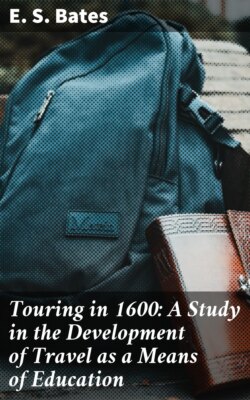Touring in 1600: A Study in the Development of Travel as a Means of Education

Реклама. ООО «ЛитРес», ИНН: 7719571260.
Оглавление
E. S. Bates. Touring in 1600: A Study in the Development of Travel as a Means of Education
Touring in 1600: A Study in the Development of Travel as a Means of Education
Table of Contents
ILLUSTRATIONS
CHAPTER I. SOME OF THE TOURISTS
CHAPTER II. GUIDE-BOOKS AND GUIDES
CHAPTER III. ON THE WATER
CHAPTER IV. CHRISTIAN EUROPE
PART I. EUROPEAN EUROPE
PART II. THE UNVISITED NORTH
PART III. THE MISUNDERSTOOD WEST
CHAPTER V. MOHAMMEDAN EUROPE
PART I. THE GRAND SIGNOR
PART II. JERUSALEM AND THE WAY THITHER
CHAPTER VI. INNS
CHAPTER VII. ON THE ROAD
CHAPTER VIII. THE PURSE
SPECIAL REFERENCES
CHAPTER 1. SOME OF THE TOURISTS
CHAPTER II. GUIDE-BOOKS AND GUIDES
CHAPTER III. ON THE WATER
CHAPTER IV. CHRISTIAN EUROPE
Part I—European Europe
Part II—The Unvisited North
Part III—The Misunderstood West
CHAPTER V. MOHAMMEDAN EUROPE
Part I—The Grand Signor
Part II—Jerusalem and the Way Thither
CHAPTER VI. INNS
CHAPTER VII. ON THE ROAD
CHAPTER VIII. THE PURSE
BIBLIOGRAPHY
INDEX
Отрывок из книги
E. S. Bates
Published by Good Press, 2019
.....
The second class of mediæval traveller, the pilgrim, is often in evidence about 1600, usually indirect evidence; the pilgrim who is nothing but pilgrim leaves practically no detailed record of himself except when he goes to Jerusalem. Yet Evelyn was told at Rome that during the year of Jubilee, 1600, twenty-five thousand five hundred women visitors were registered at the pilgrims' hospice of the Holy Trinity there, and four hundred and forty thousand men. Also, one who was at Montserrat in 1599, was told that six hundred pilgrims dined there every day, and at high festivals between three thousand and four thousand; while another (1619) learnt that whereas the monks' income from their thirty-seven estates stood at nine thousand scudi (say, thirteen thousand pounds at to-day's values) annually, they spent seven times that amount, the balance being derived from the sale of sanctified articles or from gifts.[3] On the whole, however, a decrease must be presupposed during this period on account of the cessation of pilgrimage among the Protestant half of Europe. Moreover, the kind of journeying which is specially characteristic of this period incidentally tended to further Protestant ideas and discredit pilgrimage. For pilgrimage was, of course, towards some relic. Now relics which mutually excluded each other's genuineness, such as two heads of one saint, were not likely to be met with on the same pilgrim route: the establishment of one such on a given route would hinder the establishment of a second for financial, as well as devotional, reasons. But when a believer travelled for diplomatic or educational purposes, his direction was quite as likely to lead across pilgrim routes, as along them. In which case he would be morally certain to come across these mutually exclusive relics, on one and the same journey, and the doubts thus started might be cumulative in their results.[4] On the other hand the very fact of opposition stimulated pilgrim zeal among the orthodox, as, e.g., to the still flourishing shrine of Notre Dame des Ardilliers near Saumur, as a result of Saumur itself becoming a headquarters of the "Reformed" creed. There abided of course the permanent features of life which make pilgrimage as deep-rooted as the love of children, and one of the epidemics of pilgrimage that occur periodically burst out in France about 1585, so Busbecq writes. Whole villages of people clothed themselves in white linen, took crosses and went off to some shrine two or three days' journey away. The special cause of this epidemic may perhaps be sought in the pilgrimage to Our Lady of Chartres by their queen, in 1582, to beg for relief from her barrenness. One incident of this journey ought not to be left buried in the Calendar of Foreign State Papers, the only place where it has hitherto been printed. On being told why the queen was going thither, a countrywoman said, "Alas! Madame is too late; the good priest who used to make the children has just died."
An example of the pilgrim we have already met in Della Valle. Bartholomew Sastrow in his autobiography reveals a man travelling in search of work, a very unpleasant man, perhaps, but so strikingly true a picture of the every-day life and every-day thought of a lower middle-class man of the sixteenth century as not to be surpassed for any other century, past, present, or future, not even among autobiographies.
.....